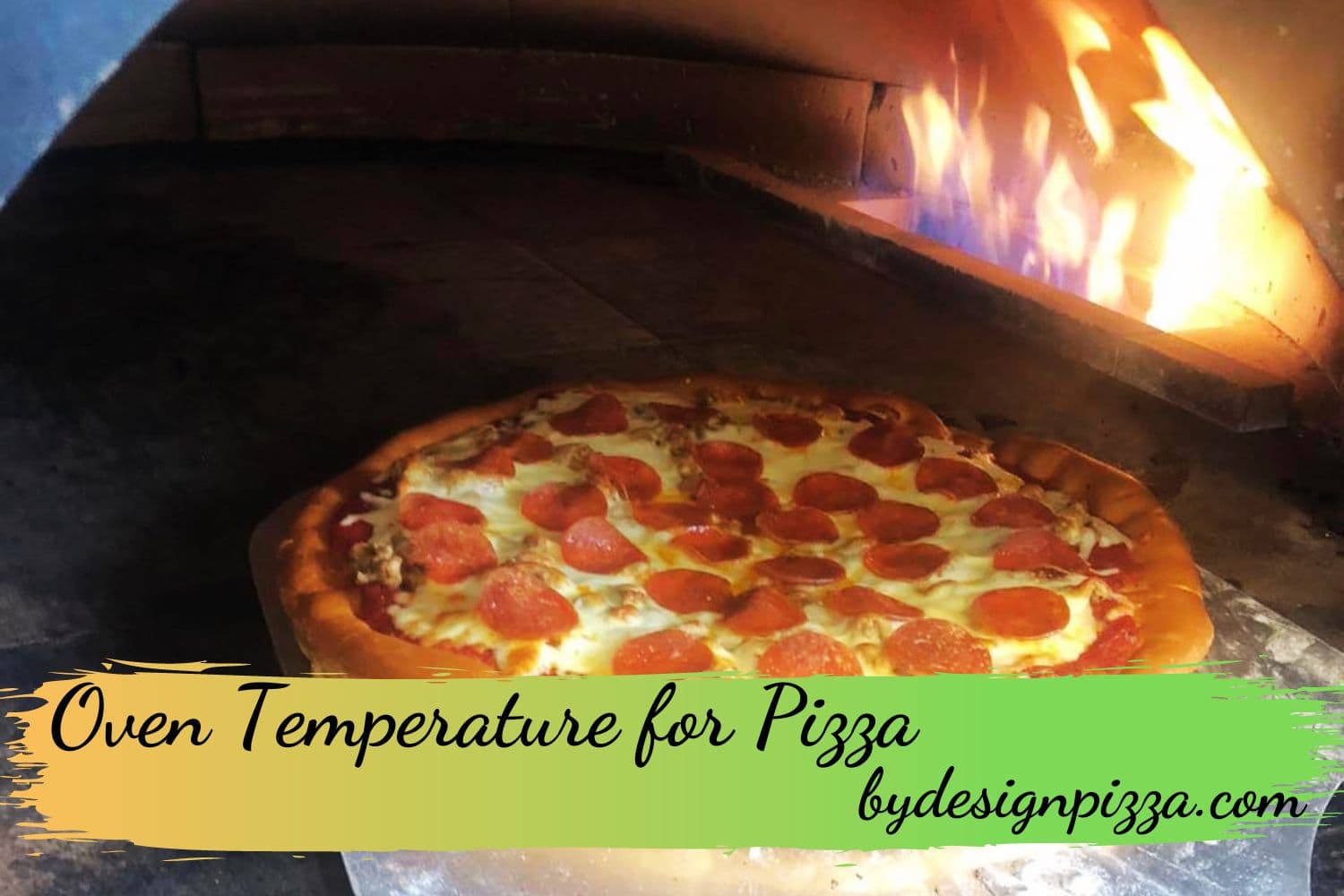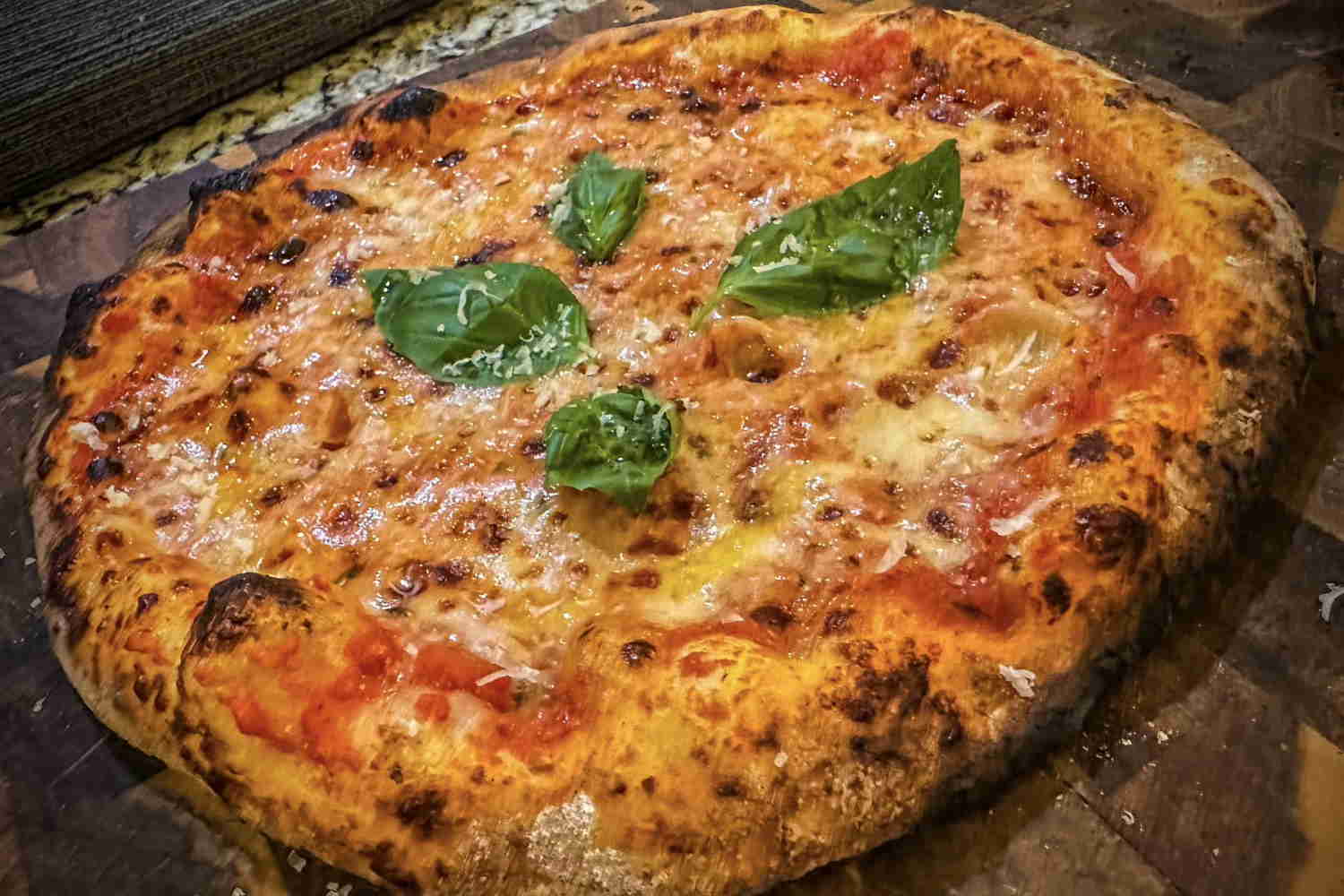Oven Temperature for Pizza

Pizza night is something the whole family can enjoy, even if you’re trying to stay at home and cook. Prepping your oven for pizza-cooking perfection isn’t as complex as many people think. With a few simple guidelines, you’ll be on your way to creating delicious homemade pizzas that are sure to please everyone in no time!
One of the key components in creating a perfect pizza is ensuring that you bake it at the right temperature. By understanding what temperatures work best for certain types of pizzas, and learning how to adjust oven settings accordingly, you can get restaurant-quality results in the comfort of your kitchen.
So, What’s the oven temperature for pizza?
Generally speaking, the best oven temperature for pizza is between 450 and 500 degrees Fahrenheit (250 to 260 Celsius). The higher heat helps give your pizza a nice, crispy crust on the bottom without burning it.
In this blog post, we’ll look at why setting your oven correctly is so essential and discuss how you can easily find the optimal temperature for all of your pizzas.
The Importance of High Heat in Pizza Ovens
Many inquire about the intense heat of pizza ovens. There are a couple of fundamental reasons for this. Firstly, high temperatures expedite the cooking process, ensuring the speedy and efficient preparation of multiple pizzas. In typical ovens, cooking several pizzas in sequence can take a while. However, in a pizza oven, each pie is ready in a couple of minutes, and the oven remains at the same high temperature for subsequent batches, eliminating the need for reheating. Additionally, the ability of the oven to retain heat and thermal mass is paramount for ideal pizza baking.
When it comes to baking a perfect pizza, the heat of the oven is crucial. One of the reasons is that it is essential for achieving the desired texture and flavor. A pizza oven needs to be heated to a degree that ensures that the pizza is evenly cooked – not overdone in one area and undercooked in another. This is often difficult to achieve with home ovens, where pizzas can become inconsistent in quality. By opting for a pizza oven instead, you can achieve a crispy crust, a chewy interior, and perfectly heated toppings without the risk of burning or leaving sections uncooked.
The secret to a delicious pizza lies in the high temperatures that Pizza Ovens can achieve. It’s all about cooking the pizza at a high temperature for only a short period, causing it to rise, crisp, and become fluffy. By doing so, you can experience a much lighter, fluffier crust that makes every bite more enjoyable. So, if you want to taste the perfect pizza every time, take an important step: ensure your pizza oven is hot enough.
How Temperature Impacts the Perfect Pizza?
The art of pizza making is not just about the ingredients – it’s also about temperature. The way you set your oven can affect everything from the crispiness of your crust to the overall taste. Whether you prefer a crispy or doughy crust, the key is to understand how temperature affects pizza baking. Adjusting the oven temperature can make all the difference in achieving the desired texture and flavor. Discover the ideal oven settings for creating the perfect pizza every time.
High temperatures, for example, create a crispy crust, while low temperatures create a soft and doughy one. By adjusting your oven temperature, you can customize your pizza’s texture and flavor to your liking.
Baking pizza dough in a hot oven produces a delightfully puffy crust with airy pockets, thanks to the quick baking process. The dough may seem hollow at first, but it becomes fully baked to create a scrumptious and easily digestible treat.
Additionally, lower-temperature cooking results in reduced moisture content, negatively influencing the texture and taste of your dough and making it more difficult to digest.
To maximize your pizza’s taste and texture, it’s wise to bake it at a higher temperature.
What Oven Temperature for Pizza?
When it comes to making delicious pizza in your oven, the temperature you choose is key.
For homemade pizzas, we recommend preheating your oven to a temperature ranging from 400°F to 500°F. Once the oven is heated, place your pizza on a stone or a preheated baking sheet for an evenly cooked crust. Large, thick-crusted pizzas may require a lower temperature to give the crust ample time to cook before the toppings burn.
For a more advanced pizza experience, try using a brick pizza oven that can reach temperatures of up to 800°F or cooking your pizza on the grill. In a commercial setting, sticking to 800°F is optimal for achieving the perfect pizza without overcooking or burning.
But for most home cooks, 450°F is a good maximum. If you crave a crunchy crust, preheat a baking sheet or cast iron skillet on the bottom of the oven and toss some ice cubes into the pan before loading the pizza.
If you have a fan-assisted oven, be sure to turn on the fan to improve airflow and increase the temperature inside the oven.
And if you’re feeling adventurous, try grilling your pizza for a unique and tasty twist. Gas mark 9 is a good temperature to aim for in gas mark ovens.
Keep in mind that preheating is crucial to getting the best results, so always wait until the oven has fully heated before placing your pizza inside. Try these tips for a delicious and perfectly cooked pizza every time.
With these tips, you’ll be well on your way to perfecting your pizza game in no time.
The Best Oven Temperature For Different Pizza Types
Oven temperature for pizza in general
Finding the perfect oven temperature for your pizza can be subjective and varies based on personal preferences. However, we offer some useful guidelines to help you achieve the best results.
For a crispier crust, preheat your oven to 450 degrees Fahrenheit, while a softer crust can be achieved by setting your oven to 350 degrees Fahrenheit. For those unsure of their preference, a happy medium between these temperatures should produce satisfactory results.
To ensure your pizza toppings are perfectly cooked, it’s important to consider their cooking time. If a topping doesn’t require a long cook time, your oven doesn’t need to be set too high.
However, if a topping takes longer, increase the temperature to avoid a burnt crust. Keep in mind that different toppings have different cook times – fresh mushrooms need more time to cook than shredded cheese as they lose moisture during cooking. So, when selecting an oven temperature for pizza, it’s important to keep these factors in mind.
When it comes to baking pizza, the right oven temperature depends on the toppings you use.
If you opt for fresh tomatoes, they’ll take longer to cook than pepperoni, so keep this in mind when selecting the perfect oven temp.
To achieve the ideal crispy crust, aim for around 500 degrees Fahrenheit when roasting your pizza.
Keep in mind that optimal temps will vary based on the toppings and type of pizza you’re making—so experiment and find what works best for your favorite recipe, whether it’s topped with cheese or pepperoni!
Oven temperature for Neapolitan pizza

For the ultimate Neapolitan pizza experience, it’s best to use a wood-fired oven that reaches temperatures between 800º and 900ºF. In a speedy 60 to 90 seconds, your pizza will be cooked to perfection and piping hot when served. Keep in mind that a conventional oven likely won’t achieve the same results.
For a conventional oven, a temperature range of 400 to 450 degrees Fahrenheit offers optimal results. This will provide for thoroughly cooked dough without any charring or overcooking. Keep in mind, however, that cooking times may vary depending on the chosen toppings. Fresh tomatoes, for instance, require a longer cooking time than pepperoni. If opting for both toppings, adjust the oven temperature to 450 degrees Fahrenheit to ensure even cooking.
Oven temperature for Deep Dish pizza
For a perfect deep dish pizza, set your oven to 375 degrees Fahrenheit for a moderate temperature that gives you a crisp exterior crust with a delightful gooey, mushy inside that will melt in your mouth.
However, keep in mind that different toppings may require varying amounts of cooking time.
Fresh mushrooms, for instance, release moisture and will need more time compared to shredded cheese. Be sure to experiment with the cooking time to find the right balance. But remember to avoid overcooking your pizza, as the crust will become too hard and crispy.
Oven temperature for New York-style pizza

Achieving the perfect New York-style pizza in your home kitchen is easier than you think – simply bake it at 500 – 550º F for 10 to 12 minutes. This tried and true method ensures a thin, crispy crust and perfectly bubbly cheese. The high temperature ensures that the toppings will remain moist and hot, while the crust achieves that sought-after crunch. To ensure success, keep a watchful eye on the crust to prevent burning.
To achieve evenly cooked toppings, the oven temperature should be adjusted accordingly as some toppings may require longer cooking time. If fresh tomatoes are one of your toppings, they’ll take a longer time to cook compared to pepperoni. To ensure that both toppings are cooked to perfection, set the oven temperature to 550 degrees Fahrenheit.
Oven temperature for Chicago deep-dish pizza
Chicago deep dish pizza with its thick crust and optimal cooking temperature of 425º F, requires approximately 25 to 30 minutes in the oven. A perfect golden brown hue awaits as the hot and juicy toppings settle into the crust.
This rule also applies to Detroit-style and stuffed crust pizzas, as their thickness necessitates a longer cooking time. Trying to rush the process with a higher temperature will only result in uncooked dough and unsatisfactory cold spots. Take the time to savor every bite of your perfect pie.
Oven temperature for St. Louis-style pizza
Discover the signature taste of St. Louis-style pizza with its coveted cracker-like crust. Achieving the perfect crust entails cooking at a temperature of 700ºF in a pizza oven. However, you can still experience the unique flavor at home by setting your oven as high as possible, around 500ºF. To ensure a perfect crust, consider par-baking it for a couple of minutes before adding your toppings and cooking it for a few more minutes. Indulge in a one-of-a-kind delicacy with St. Louis-style pizza.
What’s the Ideal Oven Temperature for Cooking Frozen Pizza?
When it comes to choosing a frozen pizza, we understand that sometimes it’s the most convenient option. Frozen pizzas usually come with cooking instructions, recommending temperatures between 425º – 450º F. It’s important to note that most frozen pizzas should be cooked from frozen, without thawing.
If you want to enhance your frozen pizza experience by adding extra cheese, pepperoni, or even garlic butter on the crust, it’s best to cook the pizza for the first half of the recommended cooking time, then add your toppings before returning it to the oven for the remainder. This method ensures everything cooks evenly.
For take-and-bake pizzas, the instructions included in the package should be followed for optimal results. You can safely cook them in your regular oven, so have no worries and enjoy!
Reheat Leftover Pizza
Want to enjoy your leftover pizza as if it was freshly baked? You have several options to reheat it, but not all of them are created equal. While the regular oven, microwave, toaster oven, and air fryer are all valid choices, your choice depends on your preference and the type of pizza you want to reheat.
Our favorite methods for reheating pizza are the toaster oven or regular oven. We find that the microwave often leaves the pizza too soft and the air fryer can make it too crunchy. However, the perfect temperature and cooking time for reheating pizza depend on many factors, such as the pizza style, crust thickness, ambient temperature, and oven type.
If you want to use pizza one, for a delicious reheated pizza experience, ensure that your oven is preheated to 375°F. Be sure to wait for the oven to fully preheat before placing the pizza inside.
So, whether you’re in the mood for a crispy or a soft reheated pizza, explore the variables and select the best reheating method for your taste buds!
Temperature to Keep Your Pizza Warm
To ensure your pizza stays warm and fresh for immediate serving, there are two smart options to choose from. One is to set your oven to low heat (around 200 degrees Fahrenheit) if you plan to serve it within an hour. The other is to use a specially designed warmer box, which is a convenient alternative that prevents your kitchen from overheating. Take your pick and enjoy a well-maintained pizza every time!
Take note that some people now opt to reheat their pizzas at home by using low temperatures for around an hour, to savor later. Although this approach gives the pizza a freshly-baked taste, the toppings’ steam may result in the dough becoming moist in time.
The Best Temperature to Bake Pizza in Different Types of Ovens
Wood-Fired Pizza Oven
How Hot Does A Wood-Fired Pizza Oven Get?
Discover the soaring temperatures of wood-fired pizza ovens. These state-of-the-art ovens can reach up to 850°F and beyond. Be mindful of your oven’s heat capacity to avoid damaging its materials. Even after the fire has burned out, the oven can maintain these high temperatures for hours. Experience the unique, smoky flavor that wood adds to your pizzas – a favorite among culinary connoisseurs.
It’s important to note that the type of wood used also affects the temperature, as some types burn hotter than others.
Best Temperature to Bake Pizza in Wood-Fired Oven
When it comes to cooking the perfect pizza, nothing beats the flavor achieved in a wood-fired brick oven. These ovens cook at a temperature of 800-900 degrees, producing a crispy, perfectly fried crust in only 3-5 minutes. You won’t have to worry about your pizza breaking or cracking apart when you take a bite.
With the advances in kitchen technology today, there’s no need to wait hours for a delicious meal prepared by a professional chef. You can create homemade pizzas with ease using a range of interchangeable components. So, why not take your pizza game to the next level and start enjoying top-quality, brick-oven-style slices right in your own home?
Convection Oven
If you want a pizza with a thin, crispy crust, you’ll want to cook it at a temperature between 325 and 350 degrees Fahrenheit in a convection oven. Why choose a convection oven over other models? They distribute heat evenly, making them ideal for baking cookies, pies, cakes, and of course, pizzas. Plus, with a convection oven, you’ll get fantastic results without overheating your kitchen. Upgrade your cooking game and try out this helpful tip today!
Electric Oven
Whether you’re using a gas burner or electric stove, cooking pizza is an easy task with delicious results. The beauty of an electric stove for pizza-making is that it evenly distributes heat, eliminating any hot or cold spots that can spoil your cuisine.
Additionally, electric burners are immensely receptive to temperature adjustments, making it simple to bake your pie to perfection without overcooking or burning.
To ascertain the perfect temperature range for electric ovens, we recommend preheating them to between 400-450 degrees Fahrenheit (204-232 Celsius). Experience top-notch pizza by following this ideal temperature guideline.
Gas Stove
Cooking pizza on a gas stove is a preferred method by many due to its even heat distribution, resulting in consistently tasty pizzas. To do so, set four burners to medium-high heat and place the pie on the center rack.
Alternatively, using two burners is possible, but ensure one flame is directly above the pizza. Experimenting with cooking temperatures is recommended to determine optimal results. Enjoy delicious homemade pizza with this simple method.
For perfectly cooked pizza, set your gas oven between 350 to 375 degrees Fahrenheit, or if you’re using a gas mark oven, set it to gas mark 9 for ideal results. This temperature range creates a crispy crust while preventing over-cooked toppings. For an even better crust, try baking your pizza at 400 degrees Fahrenheit, but be cautious not to overheat the cheese. Elevate your pizza game with these simple temperature adjustments.
Conventional Oven
How Hot Does A Conventional Oven Get?
Traditional ovens rely on coils to warm their interiors and have a large access door for entry. This design leads to frequent heat loss with each opening/closing of the door. Additionally, such ovens are usually limited to temperature ranges of no more than 500 degrees Fahrenheit due to their materials and build. Even in the unlikely event that higher temperatures are achieved, maintaining them proves difficult.
Best Temperature to Cook Pizza in a Conventional Oven
You don’t need a pizza oven to whip up an authentic pizza in the comfort of your kitchen. The secret lies in your oven’s temperature and the preheating technique. By operating at 450-500ºF and activating its maximum temperature capacity, your conventional oven can deliver mouth-watering pizza results.
Although they may take a bit longer to heat up than other appliances, the delicious result is well worth the wait!
If you’re not a fan of pizza stones, don’t fret. Simply cover your baking sheet with aluminum foil or cut out circles from folded foil and place them on the bottom rack. This will ensure that you avoid any unpleasant smoke while cooking up delicious pizzas. Remember to steer clear of empty cans, as they can melt and damage your pans.
How Do I Know If My Homemade Pizza Is Cooked?
Having trouble determining if your homemade pizza is cooked? Wonder no more – there are two ways to tell: by checking if the crust is slightly browned and if the cheese/toppings are cooked, or by feeling the crust to see if it is firm and crispy.
While checking the crust’s color is an option, each oven may yield different results, making it hard to know what cooked pizza looks like in your particular oven.
Feeling the crust is a safer way of checking for a properly cooked pizza. Here’s how: the crust should be very firm and crispy, but it’ll soften slightly as it cools. Though it may take some trial and error, you’ll soon develop a feel for when it’s just right. And don’t forget to let it cool before digging in trust us, cool pizza is always better than a mouthful of hot cheese.
The Important of a Pizza Stone
If you’re a fan of crispy crusts and delicious homemade pizza, a baking stone or pizza stone is a game-changer. These thick cooking surfaces are specifically designed for gourmet pizza-making and artisanal bread-baking. They usually come in ceramic or stone materials. For those willing to invest in the highest quality, pizza steel is also an option. Though pricier, pizza steel can withstand higher temperatures and last longer. Savor the unforgettable flavor of perfectly cooked pizzas and pieces of bread with these top-rated cooking essentials.
Enhance the quality of your homemade pizza by using a pizza stone in your home oven. These carefully crafted stones are designed to evenly distribute heat, resulting in perfectly cooked pizza every time. Don’t forget to adjust your preheating time to ensure optimal results. Take your pizza game to the next level by also utilizing your pizza stone on the grill for a delicious grilled pizza experience. Transform your pizza game with the power of a pizza stone.
Our experience shows a significant improvement in pizza quality since incorporating a pizza stone. Plus, many pizza stones are grill-safe, allowing for delicious grilled pizza. Take your pizza game to the next level with a trusty pizza stone.
While you can make decent pizzas without a pizza stone, using one can take your homemade pies to the next level.
A pizza stone or steel can help you achieve a crispier base and crust, thanks to its ability to hold heat extremely well. Unlike a normal baking tray, which quickly loses heat when you add your pizza, a pizza stone’s thickness, and efficiency mean the temperature drop will be much lower, resulting in a more even cook and that all-important crispiness.
If you’re serious about making great pizza at home, a pizza stone is simply a must-have tool. It’s also useful for baking bread, so it’s a versatile addition to any home kitchen.
FAQs
Should I Bake The Pizza In A Convection Or Regular Oven?
Both convection and regular ovens will do the trick. Convection ovens are more efficient, though they don’t necessarily produce better results than regular ovens. It depends on your personal preference and the type of pizza you’re making.
Discover the difference between using a regular oven versus a convection oven for baking your pies.
With the regular oven, you can experience a thicker, softer crust. Meanwhile, the convection oven grants you a crunchier, thinner crust. How? The fan in a convection oven circulates hot air across all parts of the pizza, ensuring even baking. Without a fan to distribute the heat, a regular oven requires you to rotate the pizza at the halfway point to avoid inconsistencies. Make the most out of your oven and enjoy a perfectly baked pizza every time.
What Temperature Should Pizza Be Served At?
For optimal safety and flavor, it is recommended to serve pizza at a temperature range of 150°F to 160°F. This ensures that the toppings and crust are fully cooked, providing a delectable and safe dining experience.
When storing pizza for later consumption, it’s essential to maintain a hot holding temperature of at least 150°F. Otherwise, refrigerating or freezing the pizza is necessary, and reheating is required before consumption.
What Is the Temperature Difference Between Conventional Ovens Vs Pizza Ovens?
Conventional ovens utilize coils for heating the enclosed space. Their construction features a spacious door that opens and closes. However, this design results in significant heat loss each time the door is opened. In addition, these ovens are constrained by their materials and build, and can generally only reach temperatures of 500 degrees Fahrenheit. Maintaining these temperatures is also a significant challenge, even if they were capable of higher temperatures.
Ever wondered how hot pizza ovens can get? Well, they can reach impressive temperatures of up to 1000 degrees Fahrenheit, with the average ranging between 700-800 degrees Fahrenheit. The unique design of pizza ovens, with a dome shape instead of a box-like structure with a door, plays a significant role in their heating capabilities.
This design helps in distributing heat evenly and retains it effectively, making pizza ovens more efficient than regular ovens. Instead of a door, there’s an opening that traps the heat within the materials.
The higher temperature of the pizza oven helps achieve that perfectly crispy crust with gooey cheese and tasty toppings. Plus, it helps cook your pizza in record time! However, most home ovens max out at 500°F, so you may not be able to get quite the same results. Still, with a bit of practice and some carefully chosen ingredients, you can make amazing pizzas with your home oven using a quality cooking surface like a pizza stone or steel.
Conclusion
We hope this blog post has given you a better understanding of the temperatures needed to properly bake your favorite pizzas. Whether you’re using a traditional oven, gas oven, or even a wood-fired oven, it is important to understand that the proper temperature will affect the taste and texture of your pizza. You may need to adjust the temperature depending on the type of pizza you are making.
No matter which type of oven or toppings you choose, with a bit of experimentation, finding the right baking temperature can be achieved so your pizzas come out perfectly every time. Bon Appétit!
Thanks for reading our article about Oven Temperature for Pizza. If you want to know more information, visit our website here.
References:
How to Make Pizza at Home That’s Better Than Takeout
The Right Oven Temperature for Homemade Pizza
I’m Vance Douglas, and I love making pizza. In fact, I love it so much that I decided to build my own oven to make it in. It’s a brick oven that I made myself, and it’s the best pizza oven you’ll ever find.
Making pizza is a passion of mine, and I’m always looking for new ways to make it even better. I’ve been making pizza for years, and I continue to learn more about the art every day. My goal is to create the perfect pizza, and I’m getting closer and closer every time.



